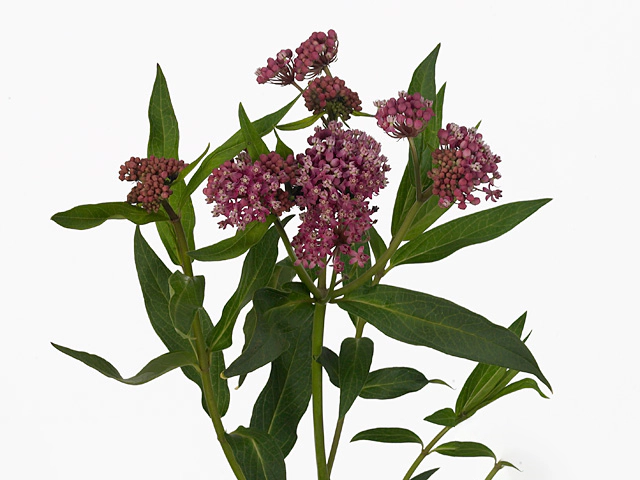Asclepias incarnata

| Leaf tip | Pointed/acute |
| Flower type | Single |
| Leaf margin | Entire |
| Winter hardness | Excellent (USDA-zone 1,2,3,4) |
| Flower color | Purple-medium purple-070B |
| Leaf, general shape | Elongate |
| Flower diameter | 1 - 10 mm |
| Flower length/hight | 1 - 10 mm |
| Leaf size | 10 - 15 cm |
| Light conditions | Sunny |
| Leaf division | Simple |
| Leaf, main color | Dark green |
| Leaf colour, pattern | Unicolored |
| Flower color distribution | Unicolored |
| Toxicity (if consumed) | Fairly |
| Moisture requirements | Well-drained |
| Soil type | Humus rich; Sandy |
Milkweed, scientifically known as Asclepias incarnata, is a fascinating plant that boasts several distinctive characteristics. This perennial herbaceous plant can be found growing naturally in various regions around the United States and Canada. It is a member of the milkweed family and is well-known for its importance in providing habitat and food for monarch butterflies and other pollinators.
One of the notable features of Asclepias incarnata is its elongated leaves, which have a pointed or acute tip. The leaves are a dark green shade and can reach a size of 10 to 15 centimeters. They have a simple division, meaning they are not deeply lobed or divided like some other plant species.
The flowers of Asclepias incarnata are single and have a diameter ranging from 1 to 10 millimeters. The color of the flowers is primarily a medium purple shade, with some variations within that range. The flowers are quite small, measuring between 1 to 10 millimeters in length or height.
These flowers add a pop of color to any garden or natural area, and their unicolored distribution gives them a uniform appearance. Butterflies and bees are particularly attracted to the flowers, making them a great choice for pollinator gardens.
In terms of hardiness, Asclepias incarnata is excellent and can thrive in USDA hardiness zones 1 to 4. This means that it can withstand cold temperatures and harsh winters, making it a versatile plant for various geographical locations.
Asclepias incarnata requires well-drained soil and thrives in sunny light conditions. It can tolerate different soil types, but it prefers humus-rich or sandy soil. Providing these ideal growing conditions will ensure that the plant flourishes and produces an abundance of flowers.
Although Asclepias incarnata is not highly toxic, it should be noted that it has a moderate toxicity level if consumed. It is important to keep this in mind, especially if you have pets or small children that might come into contact with the plant.
Additionally, proper moisture management is crucial for Milkweed's overall health. The plant requires well-drained soil to prevent waterlogged roots, but it also benefits from consistent moisture to thrive. Striking a balance in moisture level will keep the plant healthy and ensure its longevity.
Overall, Asclepias incarnata, or Milkweed, is a stunning plant that adds beauty and biodiversity to any landscape. Its unique characteristics, from its pointed leaves to its attractive purple flowers, make it a standout choice for gardens, natural areas, and wildlife habitats. By planting Milkweed, you can contribute to the conservation effort for monarch butterflies and support pollinators in your area.
Market availability index by month:
| Jan. | Feb. | Mar. | Apr. | May | Jun. | Jul. | Aug. | Sep. | Oct. | Nov. | Dec. |
|---|---|---|---|---|---|---|---|---|---|---|---|
| - | - | - | - | - | 4 | 3 | - | - | - | - | - |